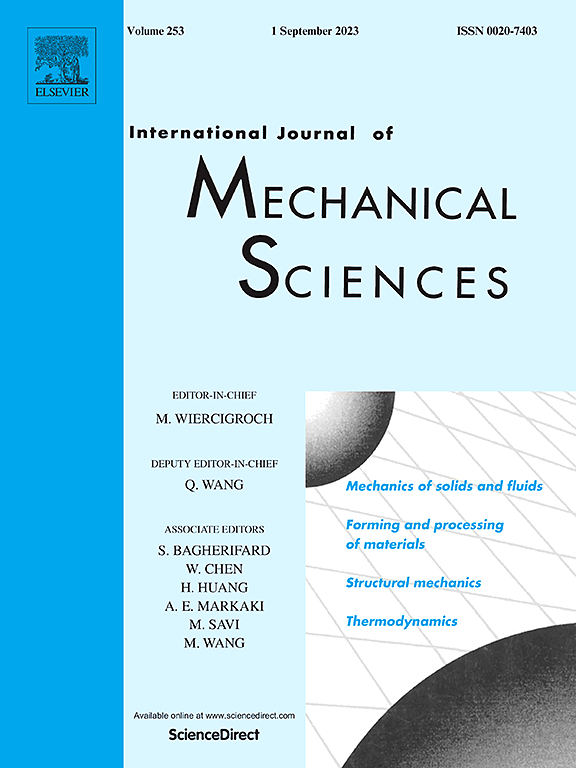Self-restoring energy dissipation mechanism via a contact-driven buckling mode transition
IF 7.1
1区 工程技术
Q1 ENGINEERING, MECHANICAL
International Journal of Mechanical Sciences
Pub Date : 2025-07-15
DOI:10.1016/j.ijmecsci.2025.110610
引用次数: 0
Abstract
This study proposes a novel self-restoring energy dissipation mechanism based on contact-driven buckling mode transition in a slender elastic column. The mechanism consists of a column adjacent to a parallel wall that enables the following sequential transitions through distinct buckling modes during a prescribed compressive displacement loading cycle: pre-contact, one-point contact, line-contact, and two-point contact. The sequence concludes with a snap-through to the opposite side followed by recovery to the initial configuration upon unloading. The resulting hysteresis in the force-displacement curve allows for passive and effective energy dissipation, while the structure elastically recovers its original configuration to enable repeatable use. Two types of boundary conditions are considered: fixed-fixed and pinned-pinned. The proposed mechanism is validated through desktop-scale experiments, finite element simulations, and analytical modeling based on the Elastica approach. Parametric studies highlight the influence of column-wall spacing on the operating limits and energy dissipation characteristics. The mechanism provides a simple and scalable basis for structural applications where reusability and passive damping are required.通过接触驱动的屈曲模态转变的自恢复能量耗散机制
提出了一种基于接触驱动的细长弹性柱屈曲模态转变的自恢复耗能机制。该机制由一根与平行壁相邻的柱组成,在规定的压缩位移加载周期内,通过不同的屈曲模式实现以下顺序过渡:预接触、一点接触、线接触和两点接触。该序列以到另一侧的快照结束,然后在卸载时恢复到初始配置。在力-位移曲线中产生的滞后允许被动和有效的能量耗散,而结构弹性地恢复其原始配置,以便重复使用。考虑了两种边界条件:固定-固定和钉-钉。通过桌面规模的实验、有限元模拟和基于Elastica方法的分析建模验证了所提出的机制。参数化研究强调柱墙间距对工作极限和能量耗散特性的影响。该机制为需要可重用性和被动阻尼的结构应用提供了简单和可扩展的基础。
本文章由计算机程序翻译,如有差异,请以英文原文为准。
求助全文
约1分钟内获得全文
求助全文
来源期刊

International Journal of Mechanical Sciences
工程技术-工程:机械
CiteScore
12.80
自引率
17.80%
发文量
769
审稿时长
19 days
期刊介绍:
The International Journal of Mechanical Sciences (IJMS) serves as a global platform for the publication and dissemination of original research that contributes to a deeper scientific understanding of the fundamental disciplines within mechanical, civil, and material engineering.
The primary focus of IJMS is to showcase innovative and ground-breaking work that utilizes analytical and computational modeling techniques, such as Finite Element Method (FEM), Boundary Element Method (BEM), and mesh-free methods, among others. These modeling methods are applied to diverse fields including rigid-body mechanics (e.g., dynamics, vibration, stability), structural mechanics, metal forming, advanced materials (e.g., metals, composites, cellular, smart) behavior and applications, impact mechanics, strain localization, and other nonlinear effects (e.g., large deflections, plasticity, fracture).
Additionally, IJMS covers the realms of fluid mechanics (both external and internal flows), tribology, thermodynamics, and materials processing. These subjects collectively form the core of the journal's content.
In summary, IJMS provides a prestigious platform for researchers to present their original contributions, shedding light on analytical and computational modeling methods in various areas of mechanical engineering, as well as exploring the behavior and application of advanced materials, fluid mechanics, thermodynamics, and materials processing.
 求助内容:
求助内容: 应助结果提醒方式:
应助结果提醒方式:


